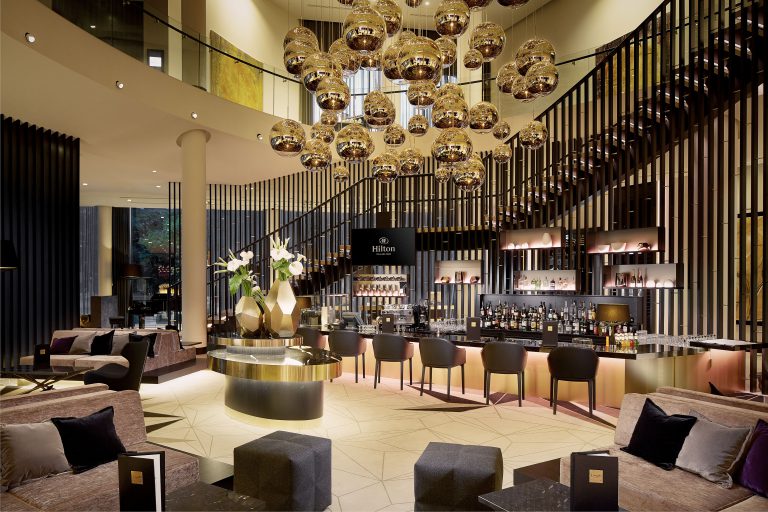Hilton Tallinn Park case study

|
|
|
Contents |
[edit] Introduction
The Hilton Tallinn Park, Estonia is a landmark hotel striving towards more sustainable performance. By following BREEAM In-Use, the project management team could adhere to a clear system to help them evaluate the existing building and compare it with best practices to support a sustainable renovation.
[edit] Building specifics
The building is located in the city centre of Tallinn, Estonia. It was built on a previously developed plot. The previous structures were dismantled and the new building was built from 2014 to 2016.
The building has 11 above ground floor levels and one below ground parking floor. The total floor area is close to 20,000 m2. The dominant use of the building is hotel rooms on floors 3 to 11. The second largest occupant is a casino located at ground floor level.
The current main tenant Hilton is aspiring to fulfil increasing demand from clients for more sustainable buildings to stay in or organise conferences in. For that reason, the current BREEAM In-Use Part 1 certification can be considered the first step to improve building performance. It is hoped that Part 2 certification will be applied for and achieved.
[edit] Green Strategy
The client’s wish was to certify the building to the highest certification level possible. The aim from the beginning was to reach a rating of at least ‘Very Good’. Using BREEAM In-Use the client got an insight into how to achieve a high quality and sustainable building.
Even though the building is recently built, there were quite a few issues in different categories that were not clearly covered by project documentation. To overcome obstacles, a couple of additional surveys and audits were conducted to identify the actual situation.
[edit] Energy highlights
The building has a very large proportion of windows and a reasonably narrow floor plan, allowing high daylight levels. Hotel clients are able to regulate thermal comfort in their rooms. Guests are able to adjust heating and cooling as well as modifying the air speed.
The building is equipped with a heating system less than five years old along with cooling and mechanical ventilation equipment. The building is connected to a district heating network with high heat source efficiency. Some areas of the building have occupancy sensor-controlled lighting which helps to avoid unnecessary energy use when not needed.
The building is located very close to the city centre with excellent access to public transport and several amenities in walking distance. Employees have the opportunity to commute with bicycles; there are secure bicycle parking spaces as well as changing and showering facilities.
The building’s water consumption is measured and measurements are accessible through BMS. The building is equipped with water efficient dual-flush WCs. All urinals in the building are water efficient and controlled by PIR sensors which, in combination, guarantee low water consumption. The conference rooms' large toilet areas are equipped with water efficient contactless hand washing fixtures.
Building security systems have been designed according to local best practices. The installed security system is certified according to international security standards. The building is in an area where no natural hazards are present.
There are four separate waste containers to collect four types of recyclable waste streams. Additionally, batteries and light bulbs are collected separately to avoid disposal at landfill stations.
The landscaping contains grassed areas and trees around the asset.
[edit] Engineering assessment
Jüri Padisaar a chief engineer at Hilton Tallinn Park feels the outcome has been beneficial for Hilton, a global player in the hospitality market. He explains, "Clients are becoming more aware of the sustainability and are more interested in the steps that companies take to make a change in their everyday procedures. To be able to show our clients the efforts that the company goes through to make the hospitality a more eco-friendly business puts us in a better position to secure new business; it also makes us proud to make an effort to show kindness towards nature.”
This article originally appeared on the BREEAM website. It was published in August 2020.
[edit] Related articles on Designing Buildings Wiki
Featured articles and news
EPC changes for existing buildings
Changes and their context as the new RdSAP methodology comes into use from 15 June.
Skills England publishes Sector skills needs assessments
Priority areas relating to the built environment highlighted and described in brief.
BSRIA HVAC Market Watch - May 2025 Edition
Heat Pump Market Outlook: Policy, Performance & Refrigerant Trends for 2025–2028.
Committing to EDI in construction with CIOB
Built Environment professional bodies deepen commitment to EDI with two new signatories: CIAT and CICES.
Government Grenfell progress report at a glance
Line by line recomendation overview, with links to more details.
An engaging and lively review of his professional life.
Sustainable heating for listed buildings
A problem that needs to be approached intelligently.
50th Golden anniversary ECA Edmundson apprentice award
Deadline for entries has been extended to Friday 27 June, so don't miss out!
CIAT at the London Festival of Architecture
Designing for Everyone: Breaking Barriers in Inclusive Architecture.
Mixed reactions to apprenticeship and skills reform 2025
A 'welcome shift' for some and a 'backwards step' for others.
Licensing construction in the UK
As the latest report and proposal to licence builders reaches Parliament.
Building Safety Alliance golden thread guidance
Extensive excel checklist of information with guidance document freely accessible.
Fair Payment Code and other payment initiatives
For fair and late payments, need to work together to add value.
Pre-planning delivery programmes and delay penalties
Proposed for housebuilders in government reform: Speeding Up Build Out.
High street health: converting a building for healthcare uses
The benefits of health centres acting as new anchor sites in the high street.
The Remarkable Pinwill Sisters: from ‘lady woodcarvers’ to professionals. Book review.
Skills gap and investment returns on apprenticeships
ECA welcomes new reports from JTL Training and The Electrotechnical Skills Partnership.


























